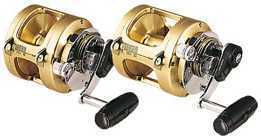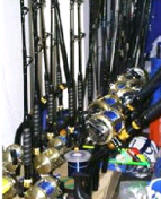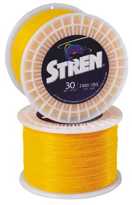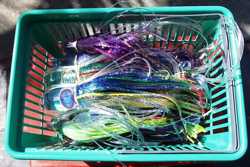02: Gearing Up
by Peter Pakula
REELS
Games reels should hold over 1,000 yards of the nominated line class, like the Shimano Tigara 50W which holds 1,000 yards of 50lb. A marlin's first run may exceed 700 yards though I have not seen any do more than 850. I've seen 50's with about 600 yards of 501b wiped out in a very short time.
Speed is very important. The larger the reel, the larger the spool, the faster the retrieve. This makes it easier to get gear in and keep a tight line while backing down and when fish nm towards you.  (However if you intend free spooling baits then you want as small and light as spool as possible to minimise spool inertia and weight)
(However if you intend free spooling baits then you want as small and light as spool as possible to minimise spool inertia and weight)
Power is the effort taken to wind the handle against the pressure of the line. The smaller the spool and the higher the gear ratio, the harder it is to wind the handle. In this there are significant differences between brands of reels.
You'll realise the importance of power when you clear rods after a strike, when having to gain line under load and when enjoying an extended battle.
under load and when enjoying an extended battle.
Two-speed have been around for ages, mainly in the domain of incredibly expensive reels such as Fin-Nor. Now most brands of reels have two speeds as standard. All my game reels are two speed, even my 4kg outfits. In fact, my 2kg bait casting outfits are two speed. I often use this facility at some stage in a lengthy fight.
Changing speed or, more precisely, changing gears, does not have anything to do with the drag settings.
The reel will be in high speed most of the time. Low gear is used when you want to turn a fish by putting maximum pressure on by keeping the rod high and using very slow, short strokes, gaining only a few inches at a time.
If a fish is deep and you cannot wind against the stretched line, low speed will enable you to do so. (It's got something to do with the difference in inertia. (Sorry, I'm not a physics teacher).
During a long fight, a tired angler can relax by dropping to low gear and winding steadily without necessarily pumping the rod. This gives the angler time to have a rest while keeping pressure on the fish and gaining line.
As soon as you can you can gain line easily on low speed, resume high speed. Drags, also know as clutches, must be smooth, easily adjusted and altered. The preference is for lever-drag reels such as Penn Internationals and Shimano TLD's (two speed) and Tiagras. Lever drags allow you to set a known drag in a known position on their drag lever arc. They often have strike buttons and markings for your preferred settings. This type of drag allows you to fight by increasing or decreasing pressures as the fight progresses - while always knowing where your predefined setting is.
In today's economy, Penn Internationals and Shimano TLD's (two speed) and Tiagras may seem expensive, but they are reliable and last a lifetime.
RODS
A game rod needs to have enough power to set hooks, enough to gain line against pressure and enough length to help an angler keep tight on a lunging, head-shaking beast.
Unfortunately, current rods can be totally misleading. They are ludicrously overrated. For example, I use a Shimano BL2705 with a 6500 Bait-runner - a perfect 6kg game spin outfit. The rod is rated for 40ib! A Sabre Unlimited makes a great 15kg rod if you cut some off the tip. It's supposed to be for 37kg.
The easiest way to test a rod's effectiveness is to stick a reel on it, thread it up and lift is rating off the floor. If you're checking a 10kg rod, lift 5kg off the floor. If the rod bends to the reel grip it's  too light. I prefer rods that bend only in their upper half. I like game rods with lots of POWER. The reasoning will become evident when I discuss fighting methods.
too light. I prefer rods that bend only in their upper half. I like game rods with lots of POWER. The reasoning will become evident when I discuss fighting methods.
Rod length is under hot debate, especially short-strokers. These short rods were designed for fighting big fish that fight deep. They are designed to give the angler maximum leverage on an immobile platform. They are, however, not that effective for fighting surface-running, jumping fish such as marlin.
Short-strokers have to be fully loaded to work. Worked quickly, they make it near impossible for all but the most-experienced angler to catch marlin effectively or efficiently.
Maintaining tight line and full drag is very difficult with a rod whose tip folds away under little pressure, leaving only 2 to 3 feet of rod that can be used to pump loaded line.
If you want marlin, especially on lures, use a longer, stiffer rod. Six to seven foot is fine. The main basis of fighting marlin is to keep the angle of line shallow, le. not straight up and down. Longer rods, used properly, will not put undue pressure on an angler, especially when using lighter line classes.
The longer and stiffer the rod, the easier it is to keep the line tight. The more line you gain per pump, and when the fish gets close the less likely you are to get cut off under the boat or around the boars propellers.
There's not much to worry about as far as guides go. Any of the Fuji aluminium oxide, silicon carbide, though the best are roller runners such as Aftco and Fin-Nor.
I own lots of game rods, using short strokers for a challenge and good old long rods for tournaments or taking out first-marlin hunters. The lighter the line class, the longer the rod. For 4kg I use an 8-footer; for 10kg 7-foot 6-inch, for 24kg a 6- foot 6-inch.
THE GOOD OIL
You're going to have to lubricate some parts of your gear before the season and after every fishing session. Use an oil or silicone based lubricant, preferably with Teflon (available from tackle and bicycle shops). Don't, use penetrating oils to lubricate any of your fishing tackle. This stuff is designed to loosen corroded bits and displace moisture. It also displaces and dissolves lubricating oils and greases. Most penetrating oils are water based and dry, leaving no protection or high friction.
Thread up your outfit, set your drag by holding the rod up, pull line off and set it to one-third the breaking strain of the line. (setting drags is discussed at length elsewhere)
Get someone to pull the line smoothly off the outfit. If the tip jerks, or if there is any tip movement at all, service the drag. If it is working properly, the tip won't move once the rod is loaded.
Clean your drags with white spirits. Let them dry before reassembling them.If the drag still doesn't operate smoothly, change the drag washers. If you service your own gear, don't over grease the gears, just apply a thin coating. Too much grease clogs the gears and may restrict your free spool.
All rods need maintenance. Wash them thoroughly in warm, soapy water. Check all guide rigs for cracks and grooves and replace any that are damaged. Roller guides should be inspected for scratches and corrosion, and of course check that they are rolling easily and smoothly and that there are no loose screws. If you don't trust them, put a drop of clear nail polish around the screw heads.
Once the rods are dried off, coat the rods with light oil and polish lightly. Put a protective coating on all grips and rub your rod winches with a fine film of grease.
LINE
If your line has in been stored where the sun can get it or under Fluro lights, don't bother checking your line if it's last season's. Take it off and throw it away! You're only going to bust off an old line if you hook up, and then you've blown a good fish (rare these days), a good day and a hundred bucks worth of lure, leader, snap swivels and hooks. You're going to have to change your line then anyway.
There are lots of types of nylon lines available. There is a need for them all, as every form of fishing has different requirements.
Threadlines need a soft nylon with little memory and thinner diameter for greater spool capacity and greater casting distance. The new copolymers are great for this. Unfortunately, these lines do not stand up to abrasion or friction.
Overhead reels and bait-casters need stiffer line, and thickness is not all that important to c asting distance. Thin lines damage easily from thumb burns when casting and damage from back lashing. So a tougher, thicker line is more advisable, especially for beginners.
asting distance. Thin lines damage easily from thumb burns when casting and damage from back lashing. So a tougher, thicker line is more advisable, especially for beginners.
Game fishing line should be good old-style nylon. It has uniform density, with no strong coatings and weak cores. As they are standard thickness, mono lines take friction and abrasion well. Note that pre-test game fishing lines are guaranteed to break at under the advertised poundage, some break way under. If you can get it tested at a Game Club or shop it's a good idea to know what you're working with. They are not guaranteed to break at a figure even close to the labelled breaking strain. For example, I set my end fight drag at around 70%, so if I used a lines a line rated at 20lb that broke way under I'd bust off!
I use only one knot for all my game fishing. the uni-knot. For doubles I use a plait, finished by forming a loop in the tag end and plaiting it four times. Then pull the double through the loop and pull the tag-end. All knots and plaits are tied very tightly.
Dacron is not outdated, but it is very difficult to handle and not very good for lure trolling. It is for experienced anglers and charter operations. It's fine if you use a 100 to 200 yard nylon Top Shot
LURES
Skirted trolling lures need maintenance, too. Do not wash them in soapy fresh water or dry them in
 direct sunlight. Rejuvenate the heads and skirts by applying white petroleum jelly or baby oil. Polish heads with a dry cloth and just rub the jelly into the skirts.
direct sunlight. Rejuvenate the heads and skirts by applying white petroleum jelly or baby oil. Polish heads with a dry cloth and just rub the jelly into the skirts.
Leaders should be checked for faults, especially around the lure front and behind the lure head. Also cheek swages or crimps for corrosion.
Hooks should be re-sharpened and re-edge the blades. Cut the barbs down for easier penetration. My barbs protrude less than 3mm for 12/0 and are virtually barb less on light-tackle hooks. Keep the points long on light tackle and strong on heavy.
Any wire used with trolling lures should be checked for fatigue.
GIMBAL BELTS and HARNESSES
If anything has revolutionised game fishing over the last ten years it is the new stand-up rod belts and harnesses. It is these that have enabled us to stand-up and fish in sometimes very small boats using all  line classes including heavy tackle.
line classes including heavy tackle.
There is huge selection, with lots of great stuff and lots more junk! A good rod belt must be comfortable for your shape. Try them until you get one that sits on your thighs (not stomach) comfortably, stick a heavy rod in it, load it up and see how it feels.
Harnesses are supposed to distribute the weight on your lower back. You can fight a fish stand-up for hours without any strain on your back if you get the right set-up.
The new "Black" Black Magic system works just fine as do brand s like Braid and Smithy's. The harness should distributes all the weight comfortably over the top of my backside and thighs, while supporting not, pressuring the lower back.
s like Braid and Smithy's. The harness should distributes all the weight comfortably over the top of my backside and thighs, while supporting not, pressuring the lower back.
Once again, stay away from cheap imitations. They not only break, losing a precious fish, but can cause serious personal injury.
GET SET
Get to know your gear. it's far better to know how your rod and reels behave before you get on the fish of a lifetime. Try this little exercise: tie a pulley under a strong tree branch or roof beam. Set up your rod and reel. Pass the line through the pulley and tie it to anything that weighs about half the breaking strain of your line.
Put on your rod belt and harness, connect up your rod, get at least 40 feet away, increase drag and pump the weight off the ground. Raise it on the back- stroke, but on the downstroke wind the reel, gaining line so that the weight does not drop. Do it until the weight hits the pulley. Now back off the drag and let it down slowly without overrunning the line.
Do this a few times until you feel comfortable. Practice getting quicker and smoother in your actions. With the weight on the ground, increase the drag until it just lifts the weight without slipping. The slower you lift, the less drag you need. At this just-not-slipping setting, raise the weight slowly on the back pump. Now try to lower the rod, winding on line without the weight dropping. You can't. Now drop to the lower speed, lower the rod slowly and wind. The smoother you are the faster you can get, and the faster you can get that weight to the pulley, the more chance you'll have on a fish! jerk the rod and the weight slides back to the ground.
Can you cast long distances with accuracy? Can you cast threadlines, baitcasters and overheads with confidence? There's no point in waiting to practice when there is a school of Yellowfin, Albacore or Skipjack busting all over the place. Normally you can only get one cast at the school. The guy who can cast furthest or the most accurately generally gets the hookup; the rest get to watch him catch another fish.
Do you know how 5kg of drag feels through your 15kg outfit? Do you know when you've reached 10kg? It's a bit late wondering what it feels like when you've got a record hanging on your hook 50 metres down. Play with your fishing rod. Hang some weights off it Get used to its feel under pressure!
The whole point of this is that you've got to get ready. Get set, so when you finally go fishing you don't think everything is ok, you know it is, for sure!





